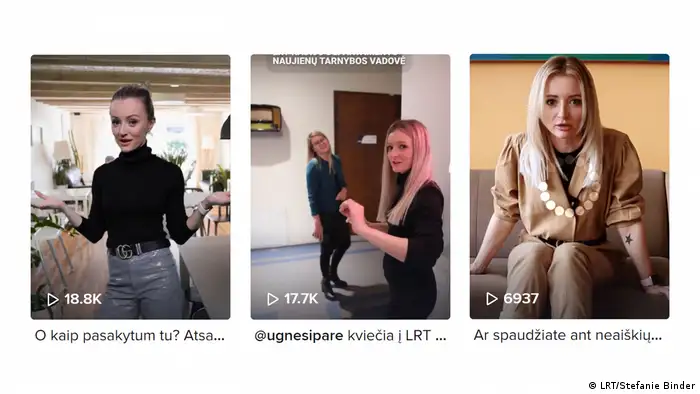Europe/Central Asia
Posting for success: Public broadcasters in the Baltics embrace TikTok
"It is crucial for public broadcasters to know how to reach out to younger audiences," said Jakov Leon at the wrap-up of a new grant program from DW Akademie and the Baltic Centre for Media Excellence.

TikTok influencer Ugne Sipare helps Lithuanian broadcaster LRT to reach more followers on social media
How do you recognize manipulative content? How should you react if you face bullying? How can you avoid electronic fraud? Why is it important not to share personal information online?
For younger people in the Baltics, social media is often their main source for information on topics that concern them. Unfortunately, it can also be an excellent source for false information. So how can they learn to tell the difference?
Public service broadcasters (PSBs) can stand as a bulwark against mis- and disinformation found on social media. Yet many broadcasters struggle to find footing with audiences below the age of 25. To attract the attention of younger generations to PSBs while increasing media information literacy on new social media platforms, DW Akademie and the Baltic Centre for Media Excellence (BCME) launched a new grant program "Youth Friendly – Sustainable: Strengthening media, networking education" with support from the Foreign Office of the Federal Republic of Germany.
The project engaged public broadcasters in the Baltics – the Lithuanian National Television and Radio (LRT) and the Estonian Public Broadcaster (ERR) – in researching youth-related topics and adjusting their tone to come up with a series of videos for younger viewers on TikTok. A crew of journalists and social media content creators, coached by DW Akademie trainers and experts, worked together to create dynamic content for the platform.
Organic, thorough, catchy
The PSBs started with TikTok videos that raised relevant questions for younger audiences, then re-directed them to radio and TV content that was more detailed.
ERR's Raadio 2 also sent young editors to the streets to speak to young people. Being from a similar age group, the journalists could broach topics such as bullying and youth happiness, then produce videos for the platform. The resulting videos have garnered over 100,000 views.
Both LRT and ERR recognized that their average content consumer is over 30 years old and predominantly male. Therefore, the focus of the program was to target young people of all genders about media and information literacy. TikTok was the obvious platform since it,
along with Instagram, is one of the two most popular social media networks among Lithuanian and Estonian youths.
Evaldas Rupkus, DW Akademie’s project officer for the Baltics, explained that media sustainability can only be achieved by becoming more youth-friendly while producing quality content for mobile users.
"Building trust and media habits take time," he stated.
Entertaining and socially relevant
According to Signe Valtina, media training program manager for BCME, the best way to reach out to young people is to involve them in discussions and the production process. They are interested in both entertainment and serious, socially relevant content.
"Don't be afraid to go to areas where you don't feel completely confident. See what works and what doesn't by doing," she recommended.
The work has already begun to pay off. LRT's in-house TikTok account has already reached almost 40,000 followers since its inception under the grant program in August 2021.
To involve more influencers in promoting the account, the Lithuanian broadcaster plans to distribute social media videos as a TV program hosted by Ugnė Siparė, an active and popular TikToker and journalist.
"It is crucial for the public service broadcasters to know via which platforms and how to reach out to young audiences, to share their values. After all they're going to finance PSBs in the future," said Jakov Leon from DW Online News during the official wrap-up of the Media and Information Literacy (MIL) project.
On December 1, 2021, the project was officially closed by presenting the results and discussing strategies for the future. The resulting plan for the PSBs and TikTok: keep on posting.
DW recommends
- Date 04.03.2022
- Feedback: Send us your feedback.
- Print Print this page
- Permalink https://p.dw.com/p/47YFS
- Date 04.03.2022
- Send us your feedback.
- Print Print this page
- Permalink https://p.dw.com/p/47YFS

